Linux 下 Socket 编程的端口问题
( Bind(): Address already in use )
转载请注明 原文: http://blog.csdn.net/xl_xunzhao/archive/2008/10/23/3130037.aspx
最近在开发一个 Linux 下的聊天软件,每次修改了源代码并再次编译运行时,常遇到下
面的地使用错误:
Cann't bind server socket !
: Address already in use
虽然用 Ctrl+C 强制结束了进程,但错误依然存在,用 netstat -an |grep 5120 和 ps
aux |grep 5120 都还能看到刚才用 Ctrl+C“强制结束”了的进程,端口还是使用中,只好
每次用 kill 结束进程,很是麻烦。昨天晚上无意间浏览到 IBM 网站上的一篇题为《 Linux
套接字编程中的
》 的文章,恍然大悟,今天试了一下,果然解决问题,在此表示
感谢,也希望更多的 coder 看到这篇文章,避免出错。
5 个隐患
主要代码为:
现在我每次用 Ctrl+C 强制结束进程后,用 netstat 和 ps 都还能看到端口在使用中,但
运行程序不会出现“Address already in use”的错误了,实现了端口的重用。
以下是原文中的第三个隐患--地址使用错误
地址使用错误(EADDRINUSE)
您可以使用 bind API 函数来绑定一个地址(一个接口和一个端口)到一个套接字端点。
可以在服务器设置中使用这个函数,以便限制可能有连接到来的接口。也可以在客户端设置
中使用这个函数,以便限制应当供出去的连接所使用的接口。bind 最常见的用法是关联端
口号和服务器,并使用通配符地址(INADDR_ANY),它允许任何接口为到来的连接所使用。
bind 普遍遭遇的问题是试图绑定一个已经在使用的端口。该陷阱是也许没有活动的套
接字存在,但仍然禁止绑定端口(bind 返回 EADDRINUSE),它由 TCP 套接字状态
TIME_WAIT 引起。该状态在套接字关闭后约保留 2 到 4 分钟。在 TIME_WAIT 状态退出之
后,套接字被删除,该地址才能被重新绑定而不出问题。
等待 TIME_WAIT 结束可能是令人恼火的一件事,特别是如果您正在开发一个套接字服
务器,就需要停止服务器来做一些改动,然后重启。幸运的是,有方法可以避开 TIME_WAIT
状态。可以给套接字应用 SO_REUSEADDR 套接字选项,以便端口可以马上重用。
考虑清单 3 的例子。在绑定地址之前,我以 SO_REUSEADDR 选项调用 setsockopt。为
了允许地址重用,我设置整型参数(on)为 1 (不然,可以设为 0 来禁止地址重用)。
使用 SO_REUSEADDR 套接字选项避免地址使用错误
�
在应用了 SO_REUSEADDR 选项之后,bind API 函数将允许地址的立即重用。
附录:man setsockopt
参考资料:
Linux 套接字编程中的 5 个隐患
http://www.ibm.com/developerworks/cn/linux/l-sockpit/
本文引用地址:http://blog.csdn.net/xl_xunzhao/archive/2008/10/23/3130037.aspx
附录:
man setsockopt 摘自 Open Group
原文:http://www.opengroup.org/onlinepubs/7990989775/xns/setsockopt.html
NAME
setsockopt - set the socket options
SYNOPSIS
#include
int setsockopt(int socket, int level, int option_name, const void
*option_value, socklen_t option_len);
DESCRIPTION
The setsockopt() function sets the option specified by the option_name
argument, at the protocol level specified by the level argument, to
the value pointed to by the option_value argument for the socket
associated with the file descriptor specified by the socket argument.
�
The level argument specifies the protocol level at which the option
resides. To set options at the socket level, specify the level
argument as SOL_SOCKET. To set options at other levels, supply the
appropriate protocol number for the protocol controlling the option.
For example, to indicate that an option will be interpreted by the TCP
(Transport Control Protocol), set level to the protocol number of TCP,
as defined in the header, or as determined by using
getprotobyname().
The option_name argument specifies a single option to set. The
option_name argument and any specified options are passed
uninterpreted to the appropriate protocol module for interpretations.
The header defines the socket level options. The
options are as follows:
SO_DEBUG
Turns on recording of debugging information. This option enables
or disables debugging in the underlying protocol modules. This
option takes an int value. This is a boolean option.
SO_BROADCAST
Permits sending of broadcast messages, if this is supported by the
protocol. This option takes an int value. This is a boolean
option.
SO_REUSEADDR
Specifies that the rules used in validating addresses supplied to
bind() should allow reuse of local addresses, if this is supported
by the protocol. This option takes an int value. This is a
boolean option.
SO_KEEPALIVE
Keeps connections active by enabling the periodic transmission of
messages, if this is supported by the protocol. This option takes
an int value. If the connected socket fails to respond to these
messages, the connection is broken and processes writing to that
socket are notified with a SIGPIPE signal. This is a boolean
option.
SO_LINGER
Lingers on a close() if data is present. This option controls the
action taken when unsent messages queue on a socket and close() is
performed. If SO_LINGER is set, the system blocks the process
�
during close() until it can transmit the data or until the time
expires. If SO_LINGER is not specified, and close() is issued, the
system handles the call in a way that allows the process to
continue as quickly as possible. This option takes a linger
structure, as defined in the header, to specify
the state of the option and linger interval.
SO_OOBINLINE
Leaves received out-of-band data (data marked urgent) in line.
This option takes an int value. This is a boolean option.
SO_SNDBUF
Sets send buffer size. This option takes an int value.
SO_RCVBUF
Sets receive buffer size. This option takes an int value.
SO_DONTROUTE
Requests that outgoing messages bypass the standard routing
facilities. The destination must be on a directly-connected
network, and messages are directed to the appropriate network
interface according to the destination address. The effect, if
any, of this option depends on what protocol is in use. This
option takes an int value. This is a boolean option.
SO_RCVLOWAT
Sets the minimum number of bytes to process for socket input
operations. The default value for SO_RCVLOWAT is 1. If SO_RCVLOWAT
is set to a larger value, blocking receive calls normally wait
until they have received the smaller of the low water mark value
or the requested amount. (They may return less than the low water
mark if an error occurs, a signal is caught, or the type of data
next in the receive queue is different than that returned, e.g.
out of band data). This option takes an int value. Note that not
all implementations allow this option to be set.
SO_RCVTIMEO
Sets the timeout value that specifies the maximum amount of time
an input function waits until it completes. It accepts a timeval
structure with the number of seconds and microseconds specifying
the limit on how long to wait for an input operation to complete.
If a receive operation has blocked for this much time without
�
receiving additional data, it returns with a partial count or
errno set to [EAGAIN] or [EWOULDBLOCK] if no data were received.
The default for this option is zero, which indicates that a
receive operation will not time out. This option takes a timeval
structure. Note that not all implementations allow this option to
be set.
SO_SNDLOWAT
Sets the minimum number of bytes to process for socket output
operations. Non-blocking output operations will process no data if
flow control does not allow the smaller of the send low water mark
value or the entire request to be processed. This option takes an
int value. Note that not all implementations allow this option to
be set.
SO_SNDTIMEO
Sets the timeout value specifying the amount of time that an
output function blocks because flow control prevents data from
being sent. If a send operation has blocked for this time, it
returns with a partial count or with errno set to [EAGAIN] ore
[EWOULDBLOCK] if no data were sent. The default for this option is
zero, which indicates that a send operation will not time out.
This option stores a timeval structure. Note that not all
implementations allow this option to be set.
For boolean options, 0 indicates that the option is disabled and 1
indicates that the option is enabled.
Options at other protocol levels vary in format and name.
RETURN VALUE
Upon successful completion, setsockopt() returns 0. Otherwise, -1 is
returned and errno is set to indicate the error.
ERRORS
The setsockopt() function will fail if:
[EBADF]The socket argument is not a valid file descriptor.
[EDOM]The send and receive timeout values are too big to fit into the
timeout fields in the socket structure.
[EFAULT]The option_value parameter can not be accessed or written.
�
[EINVAL]The specified option is invalid at the specified socket level
or the socket has been shut down.
[EISCONN]The socket is already connected, and a specified option can
not be set while the socket is connected.
[ENOPROTOOPT]The option is not supported by the protocol.
[ENOTSOCK]The socket argument does not refer to a socket.
The setsockopt() function may fail if:
[ENOMEM]There was insufficient memory available for the operation to
complete.
[ENOBUFS]Insufficient resources are available in the system to
complete the call.
[ENOSR]There were insufficient STREAMS resources available for the
operation to complete.
APPLICATION USAGE
The setsockopt() function provides an application program with the
means to control socket behaviour. An application program can use
setsockopt() to allocate buffer space, control timeouts, or permit
socket data broadcasts. The header defines the socket-
level options available to setsockopt().
Options may exist at multiple protocol levels. The SO_ options are
always present at the uppermost socket level.
SEE ALSO
bind(), endprotoent(), getsockopt(), socket(), .
�
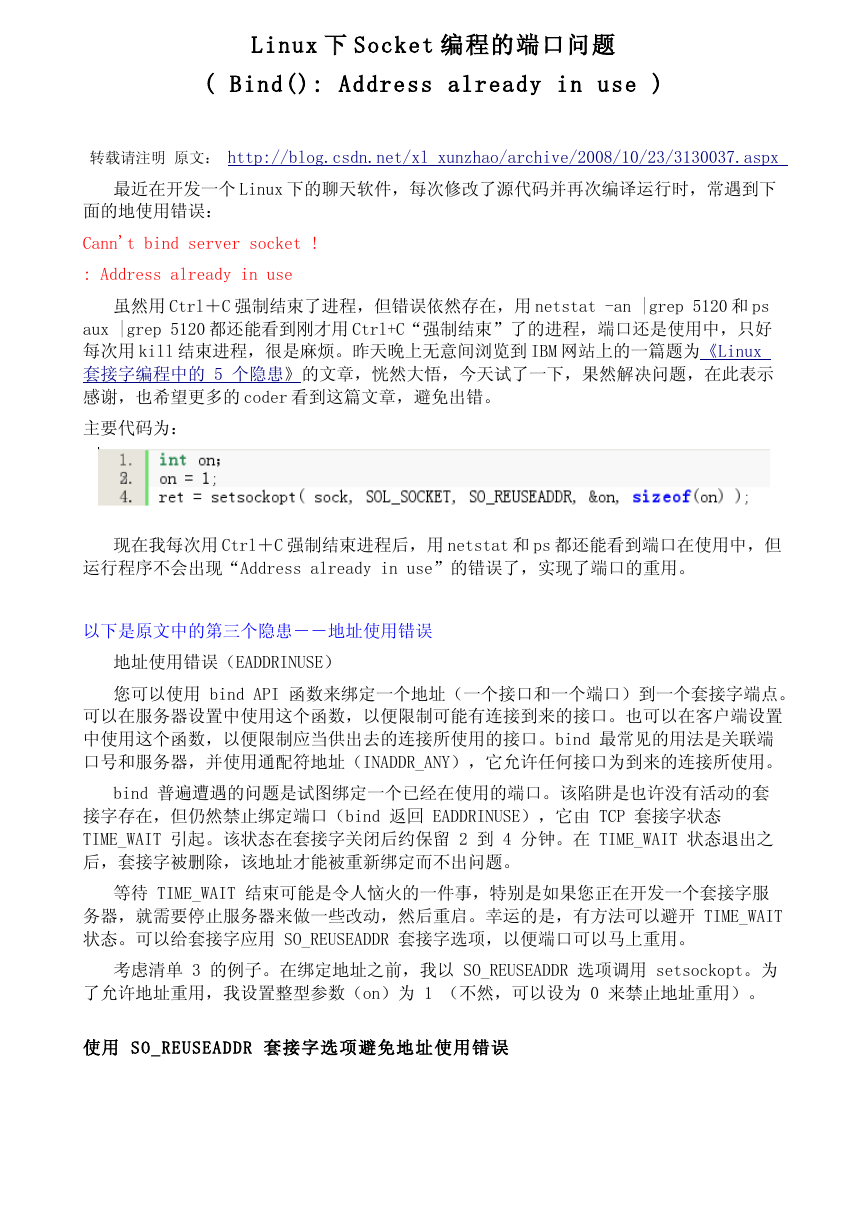
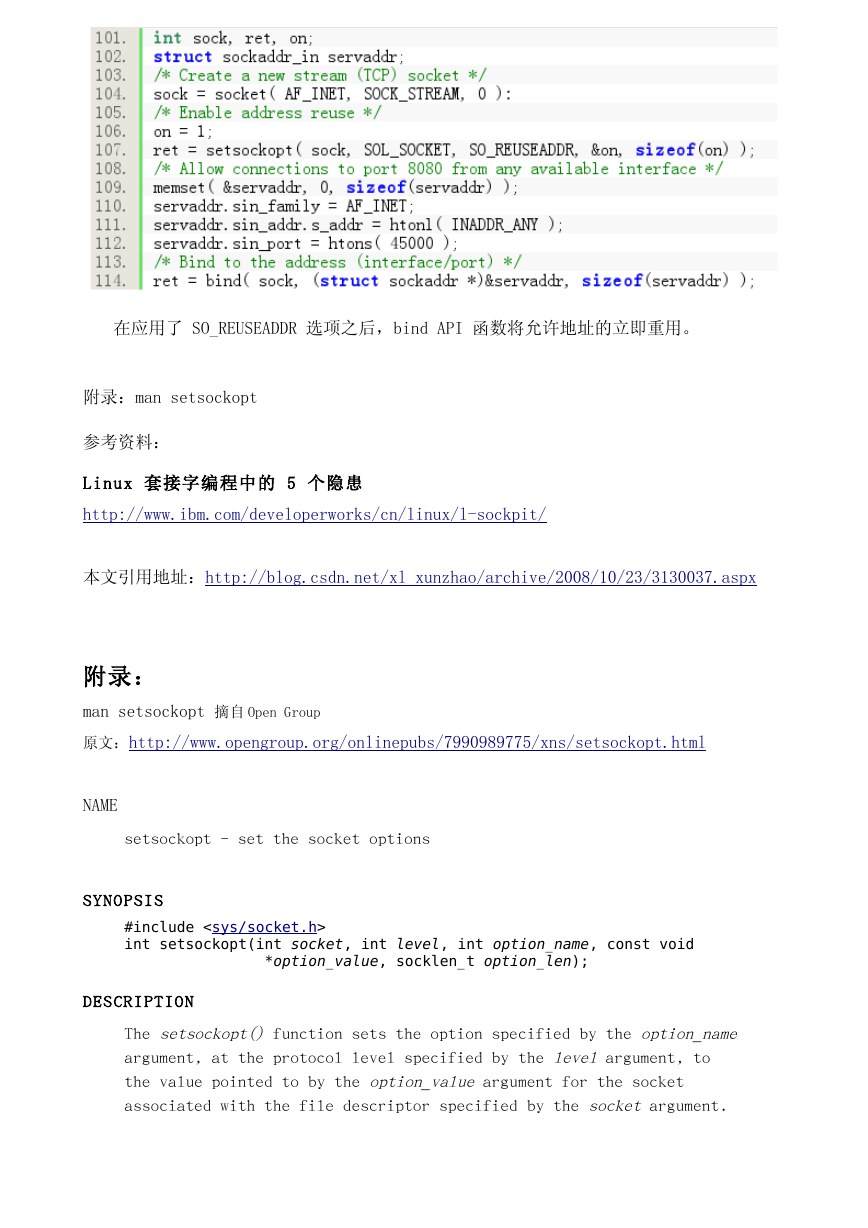
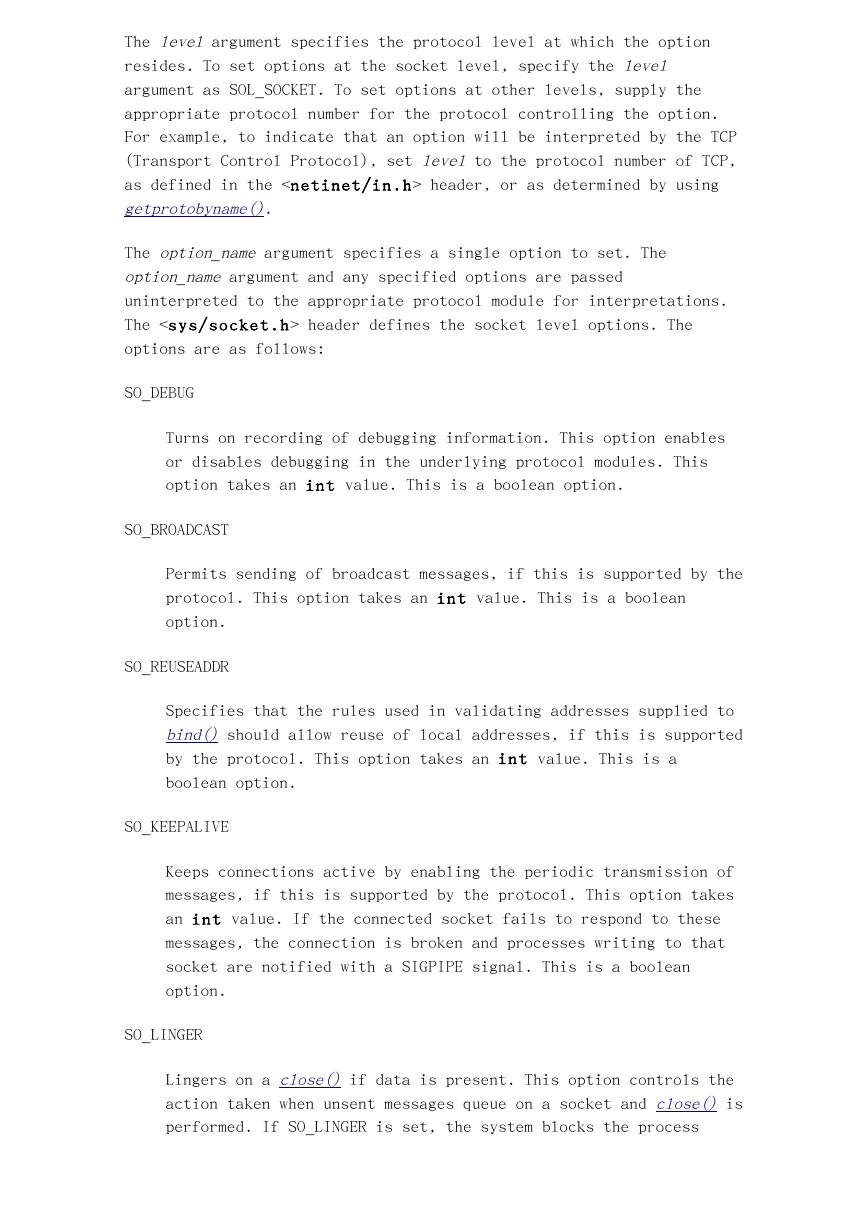
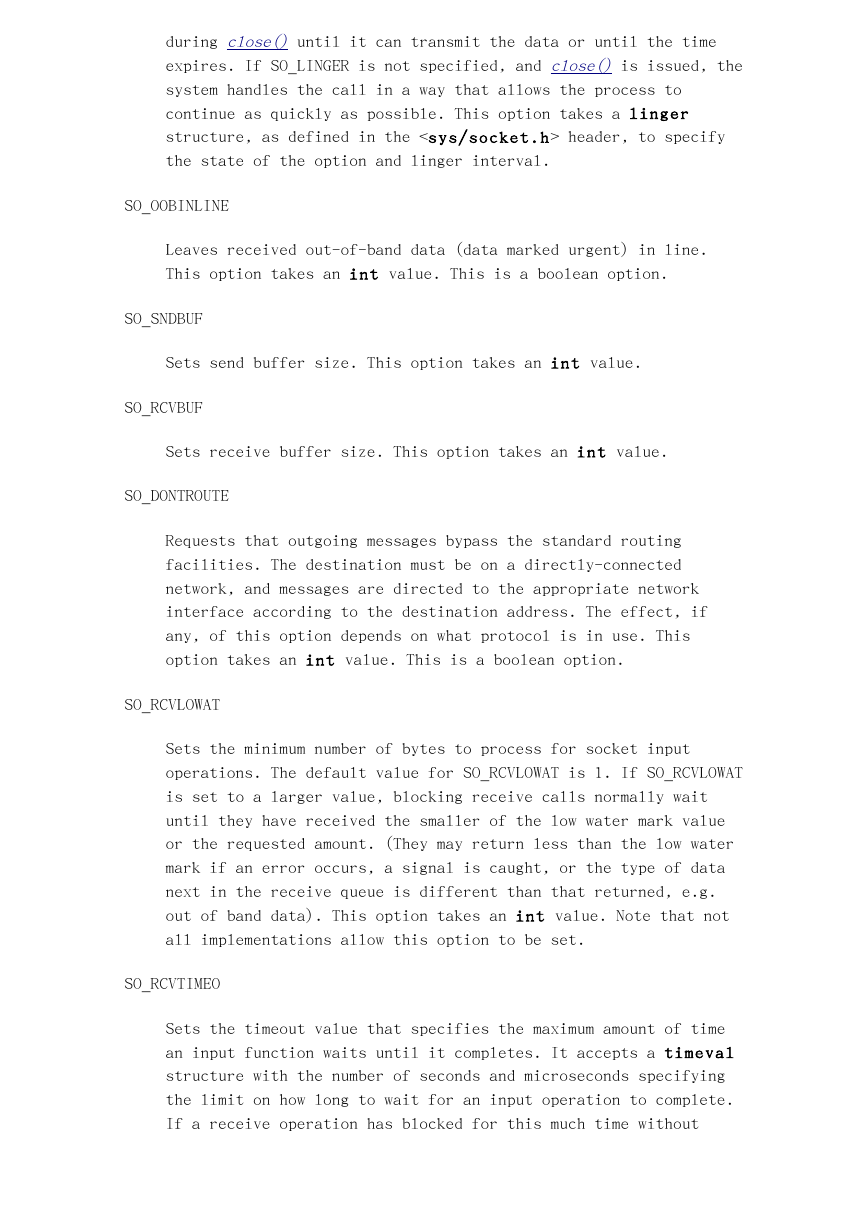
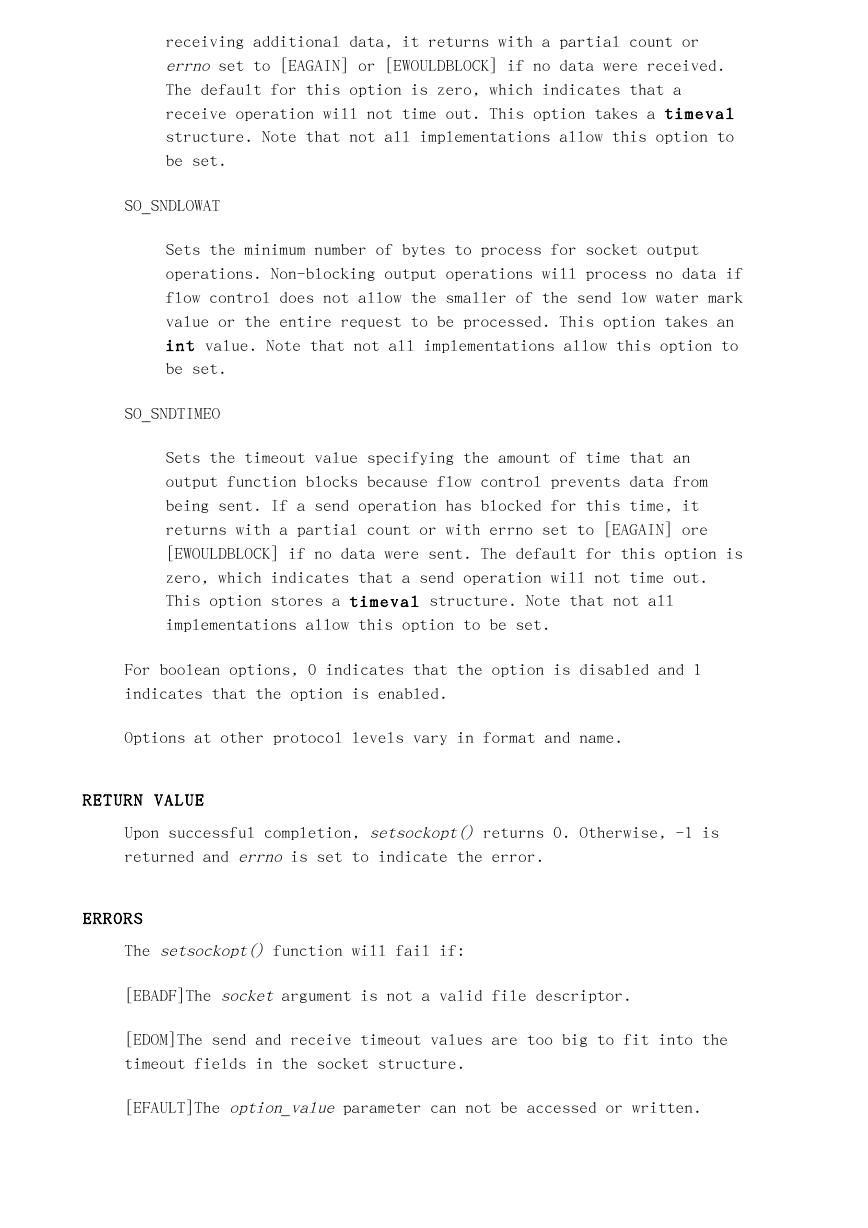
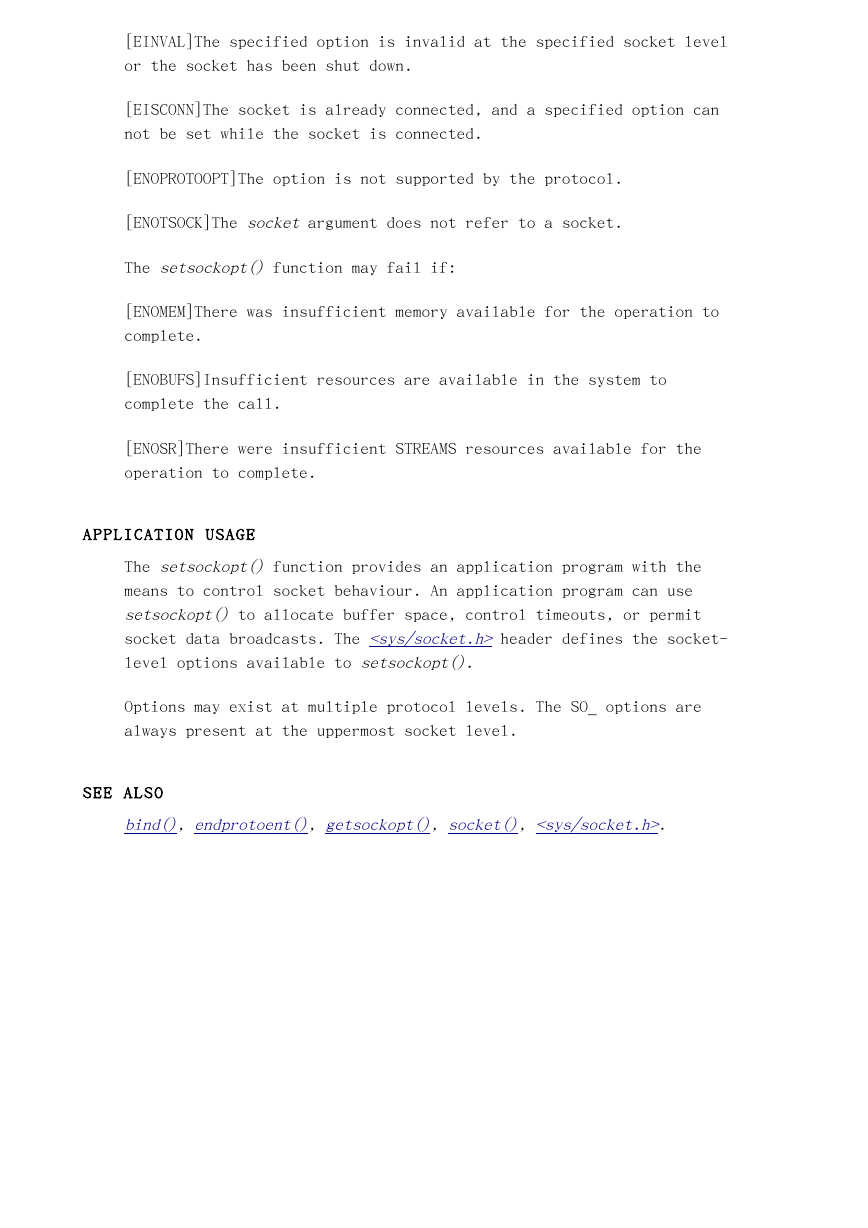






 2023年江西萍乡中考道德与法治真题及答案.doc
2023年江西萍乡中考道德与法治真题及答案.doc 2012年重庆南川中考生物真题及答案.doc
2012年重庆南川中考生物真题及答案.doc 2013年江西师范大学地理学综合及文艺理论基础考研真题.doc
2013年江西师范大学地理学综合及文艺理论基础考研真题.doc 2020年四川甘孜小升初语文真题及答案I卷.doc
2020年四川甘孜小升初语文真题及答案I卷.doc 2020年注册岩土工程师专业基础考试真题及答案.doc
2020年注册岩土工程师专业基础考试真题及答案.doc 2023-2024学年福建省厦门市九年级上学期数学月考试题及答案.doc
2023-2024学年福建省厦门市九年级上学期数学月考试题及答案.doc 2021-2022学年辽宁省沈阳市大东区九年级上学期语文期末试题及答案.doc
2021-2022学年辽宁省沈阳市大东区九年级上学期语文期末试题及答案.doc 2022-2023学年北京东城区初三第一学期物理期末试卷及答案.doc
2022-2023学年北京东城区初三第一学期物理期末试卷及答案.doc 2018上半年江西教师资格初中地理学科知识与教学能力真题及答案.doc
2018上半年江西教师资格初中地理学科知识与教学能力真题及答案.doc 2012年河北国家公务员申论考试真题及答案-省级.doc
2012年河北国家公务员申论考试真题及答案-省级.doc 2020-2021学年江苏省扬州市江都区邵樊片九年级上学期数学第一次质量检测试题及答案.doc
2020-2021学年江苏省扬州市江都区邵樊片九年级上学期数学第一次质量检测试题及答案.doc 2022下半年黑龙江教师资格证中学综合素质真题及答案.doc
2022下半年黑龙江教师资格证中学综合素质真题及答案.doc